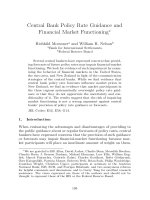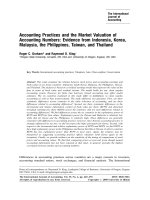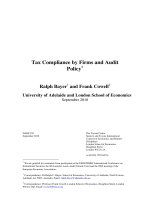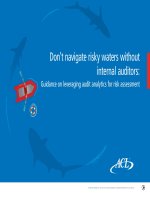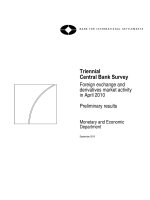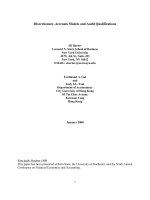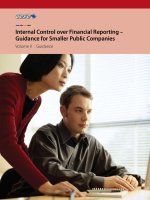Internal control opinion shopping and audit market competition
Bạn đang xem bản rút gọn của tài liệu. Xem và tải ngay bản đầy đủ của tài liệu tại đây (291.24 KB, 50 trang )
Trinity University
Digital Commons @ Trinity
School of Business Faculty Research
3-2015
Internal Control Opinion Shopping and Audit
Market Competition
Nathan J. Newton
Julie Persellin
Trinity University
Dechun Wang
Michael S. Wilkins
Trinity University,
Follow this and additional works at: />Repository Citation
Newton, Nathan J. and Persellin, Julie and Wang, Dechun and Wilkins, Michael S., Internal Control Opinion Shopping and Audit
Market Competition (March 13, 2015). Available at SSRN: or />ssrn.2503660
This Working Paper is brought to you for free and open access by Digital Commons @ Trinity. It has been accepted for inclusion in School of Business
Faculty Research by an authorized administrator of Digital Commons @ Trinity. For more information, please contact
Internal Control Opinion Shopping and Audit Market Competition
Nathan J. Newton
Assistant Professor
University of Missouri – Columbia
Julie Persellin
Assistant Professor
Trinity University
Dechun Wang
Associate Professor
Texas A&M University
Michael S. Wilkins
Jesse H. Jones Professor
Trinity University
March 2015
*We would like to thank Kathleen Bentley, Cory Cassell, Chris Hogan, Brian Mayhew, Jaime
Schmidt, Scott Vandervelde, and participants at the 2015 AAA Audit Midyear Meeting for
helpful comments and suggestions.
Internal Control Opinion Shopping and Audit Market Competition
Abstract
This study examines whether audit clients engage in internal control opinion shopping activities
and whether audit market competition appears to facilitate those activities. Regulators have long
been concerned about the impact of both audit market competition and opinion shopping on audit
quality. We adopt the framework developed in Lennox (2000) to construct a proxy to measure
the tendency that clients engage in internal control opinion shopping activities. Our empirical
results suggest that clients are successful in shopping for clean internal control opinions. In
addition, we find evidence that internal control opinion shopping occurs primarily in competitive
audit markets. Finally, our results indicate that among auditor dismissal clients, opinion shopping
is more likely to occur when dismissals are made relatively late during a reporting period and
when audit market competition is high. Our findings have implications for the current policy
debate regarding audit quality and audit market competition.
Key words: opinion shopping; internal control weakness; audit opinion; audit quality; audit
market competition
Page 2
Internal Control Opinion Shopping and Audit Market Competition
I. INTRODUCTION
Opinion shopping has long been of concern to regulators (U.S. Senate 1976; SEC 1988;
PCAOB 2011b). The Treadway Commission Report notes that differences of opinion between
client management and auditors may prompt management to consult with another auditor “to
obtain an opinion that coincides with management’s interest in presenting the results in the most
favorable light” (Mintz 1995). While prior research has provided evidence that clients are
successful in shopping for clean audit opinions in markets outside the U.S., there is limited
evidence that clients in the U.S. engage in audit opinion shopping.1 Our purpose in this paper is
to broaden the traditional opinion shopping setting to include opinions related to the
effectiveness of internal control over financial reporting (hereafter, internal control opinions). In
so doing, we provide an alternative laboratory within which issues related to audit quality and
potential compromises in auditor independence may be evaluated.
Our motivation for investigating whether companies appear to shop for favorable internal
control opinions comes from two sources. First, Defond and Zhang (2014) suggest that the topic
of opinion shopping is important but note that research in this area has not been particularly
productive. Specifically, Defond and Zhang (2014) state that the primary limitations of opinion
shopping research are that the results do not seem to be generalizable to the U.S., and that the
evidence that does exist is based exclusively on the use of audit opinions as a proxy for audit
quality. The authors suggest that the importance of opinion shopping is not attributable to the
mechanism itself (i.e., the audit opinion) but because the mechanism is one of many factors that
may be associated with compromised auditor independence. By investigating a mechanism that
1
Lennox (2002) and Carcello and Neal (2003) provide evidence consistent with audit opinion shopping in the U.S.
during pre-SOX years. We discuss potential differences between pre-SOX and post-SOX opinion shopping in
Section V.
Page 1
is very similar to financial statement audit opinions but that is associated with a much higher
incidence of unfavorable outcomes for audit clients, we seek to shed light on potential audit
quality and independence concerns that are related to the audit reporting process.
Our second reason for investigating internal control opinion shopping is based on
numerous reports mentioning surprisingly low numbers of reported material weaknesses. For
example, a recent Wall Street Journal article notes that Audit Analytics reported 629 material
weaknesses in the first year after the Sarbanes-Oxley Act (SOX) was adopted but only 141 such
weaknesses in 2011 (Chasan 2013). There is little doubt that genuine improvement in SEC
registrants’ internal controls has occurred since the passage of SOX. However, Chasan (2013)
cites a concern that the infrequency of reported material weaknesses may be related to a potential
“lack of rigor around material weakness testing” as observed by the Office of the Chief
Accountant, the SEC’s Division of Corporation Finance, and the PCAOB. The PCAOB’s Staff
Audit Practice Alert No. 11 (October 24, 2013) states that in 15 percent of the audit engagements
occurring during a recent three-year reporting period, inspections staff found that the audit firm
“had failed to obtain sufficient appropriate evidence to support its opinion on the effectiveness of
internal control due to one or more auditing deficiencies identified by the inspections staff”
(PCAOB 2013b). Furthermore, the Deputy Chief Accountant recently commented, “in some
instances companies – managers and auditors – are not adequately evaluating the severity of
[internal control] deficiencies. That may mean that some of the deficiencies are being classified
as significant deficiencies, when they are really material weaknesses and investors aren’t getting
the disclosures that are intended” (Mont 2015). To the extent that questionable audit rigor and/or
potentially misclassified internal control deficiencies at least partially reflect acquiescence to
Page 2
client preferences, the existence of internal control opinion shopping would be consistent with
these regulatory findings and concerns.
Based on the above, our first research question asks whether internal control opinion
shopping appears to occur in U.S. markets – that is, whether adverse internal control opinions
would have been issued more frequently if audit clients had made different decisions regarding
their incumbent auditors. Ettredge, Heintz, Li, and Scholz (2011) find that clients with adverse
internal control opinions are more likely than clients with clean opinions to dismiss their auditors
and to choose higher quality replacements. They interpret these findings as suggesting that the
auditor dismissal decisions made by clients with adverse internal control opinions reflect, on
average, a desire to improve or signal the improvement of their financial reporting quality.
Although Ettredge et al. (2011) is somewhat related to our study and we generally concur with
their findings, it is important to note that our purpose is to determine whether a client’s decision
regarding the future of its incumbent auditor is related to the relative likelihood, ex ante, of
receiving a clean versus adverse internal control opinion. More specifically, we present a
probabilistic analysis of both auditor retention and auditor dismissal decisions that allows us to
test more directly whether audit clients appear to engage in internal control opinion shopping.
The second research question we investigate relates to how competition among auditors
affects clients’ internal control opinion shopping activities. At issue is whether audit market
competition strengthens or compromises auditor independence. Policy makers and regulators
worry that consolidation in the audit market has caused audit quality to decrease (e.g., U.S.
Chamber of Commerce 2006, Rappeport 2008). The maintained assumption among these parties
seems to be that competition among auditors is desirable. However, when the PCAOB issued a
2011 concept release on mandatory auditor rotation, some commenters expressed concern that
Page 3
the heightened audit market competition attributable to mandatory auditor rotation could
motivate opinion shopping activities, thereby decreasing audit quality (PCAOB 2011a).
Although the PCAOB dropped their auditor rotation proposal in 2013, the debate over audit
market competition has continued. We hope to inform this debate by providing insights on how
opinion-shopping activities might be influenced by audit market competition.
Our third research question explores whether the timing of auditor dismissals seems to be
related to opinion shopping. Although internal control deficiencies may be found throughout the
year, auditors typically do not make a final judgment on their internal control opinions until
relatively late in the reporting period. Given that a client is most likely to engage in opinion
shopping when it is able to reliably predict what the incumbent auditor’s opinion is going to be,
the timing of a dismissal may be indicative of whether it is more likely to have been motivated
by opinion shopping. Our analysis in this area complements previous research related to the
timing of auditor dismissals and audit opinion shopping and also speaks to the possibility that
additional scrutiny may need to be applied to auditor changes that occur close to clients’ fiscal
year-ends (e.g., Schwartz and Soo 1996).
To address our first research question, we adopt the “what if” framework of Teoh (1992)
and Lennox (2000) and investigate the relationship between internal control opinion shopping
and auditor dismissal and retention decisions. More specifically, we use an adverse internal
control opinion model to estimate the probability (P1) of a client receiving an adverse internal
control opinion if the client dismisses its auditor and the probability (P0) of the same client
receiving an adverse internal control opinion if the client does not dismiss its auditor. A client is
said to be engaging in opinion shopping if P1 is less than P0 and the client dismisses its auditor
or if P1 is greater than P0 and the client retains its auditor. Using U.S. data from 2005-2011, we
Page 4
provide evidence suggesting that clients successfully engage in internal control opinion
shopping. When we include a comparably constructed measure of going concern (GC) opinion
shopping in the same model, our internal control opinion shopping measure remains significant
while the GC opinion shopping measure is not significant. Our conclusion is that adverse internal
control opinions convey more information (and/or less predictable information) than GC
opinions about important financial reporting problems; hence, firms have a greater incentive to
attempt to manage the internal control reporting process than to manage the going concern
reporting process.
For our second research question, we use competition measures employed by Numan and
Willekens (2012) and others to test the relationship between audit market competition and
internal control opinion shopping. Our proxies are based on the Herfindahl Index and two spatial
competition measures that assess the market share distance between the incumbent auditor and
its closest competitor within a Metropolitan Statistical Area (MSA). Numan and Willekens
(2012) argue that the spatial competition measures are suitable proxies for auditor competition
because the audit market is oligopolistic in nature. Our results indicate that while internal control
opinion shopping does appear to exist on average, it tends to be most pervasive when audit
market competition is relatively high. The finding that audit market competition may facilitate
successful opinion shopping is consistent with recent studies (e.g., Newton, Wang and Wilkins
2013) suggesting that increased competition in U.S. audit markets may actually impact audit
quality negatively.
To test our third research question, we define “late dismissals” as observations where
clients dismiss auditors in the third quarter or later and “early dismissals” as observations where
clients dismiss auditors in the second quarter or earlier. Based on these categories, we find that
Page 5
opinion shopping among clients that dismiss their auditors is more likely when auditors are
dismissed late in the reporting period. We also find that in highly competitive audit markets, late
dismissals occur relatively more frequently than early dismissals and also are much more likely
to be associated with opinion shopping.
Our study is important for a number of reasons. First, despite long-standing concerns
about the dangers of opinion shopping and what seems to be a widely held belief that such
activities do take place, our study is the first to document the existence of opinion shopping in
any form in the post-SOX era. Second, our finding that internal control opinion shopping appears
to exist while audit opinion shopping does not suggests that audit clients view internal control
reports as being more important than audit reports. As such, regulators may wish to increase their
monitoring of internal control issues, particularly since concerns have already been expressed by
the PCAOB that audit firms may not be collecting enough evidence to support their internal
control opinions. Third, our finding that internal control opinion shopping is more likely in
competitive audit markets informs the continuing debate regarding the pros and cons of
increased auditor competition. More specifically, our results suggest that attempts to increase
competition between audit firms may impact audit quality negatively.
The remainder of this paper is organized as follows. In Section II we describe the
auditor’s responsibilities in audits of internal control over financial reporting. In Section III we
present background information related to opinion shopping and also develop our three research
questions. In Section IV we discuss our research design and sample characteristics. Section V
presents our primary empirical results and additional tests, and in Section VI we provide
concluding remarks.
Page 6
II. AUDITS OF INTERNAL CONTROL OVER FINANCIAL REPORTING
Section 404 of the Sarbanes-Oxley Act requires both management and the external
auditors to report on the operating effectiveness of internal control over financial reporting
(ICFR). While auditors have been responsible for assessing internal control for over two decades
(AICPA 1988), early evaluations were required primarily for planning and risk assessment
purposes. Prior to SOX, auditors could choose not to rely on a poorly designed or functioning
internal control by increasing the level of substantive testing performed in order to obtain
sufficient evidence to support the audit opinion. The passage of SOX elevated both the
complexity involved in obtaining an adequate understanding and proper evaluation of internal
control as well as the transparency of the subsequent findings.
The objective in an audit of ICFR is to express an opinion on the operating effectiveness
of the controls. Therefore, the focus of the audit is on evaluating the severity of control
deficiencies discovered in order to determine whether any are serious enough to potentially
undermine effective ICFR. A material weakness is defined by the PCAOB as a deficiency in
ICFR such that there is a reasonable possibility that a material misstatement of the annual or
interim financial statements will not be prevented or detected on a timely basis (PCAOB 2007).
Therefore, if one or more material weaknesses exist that have not been remediated as of yearend, the company's ICFR cannot be considered effective and an adverse internal control opinion
must be issued. Significant deficiencies in internal control may also be identified over the course
of an audit. A significant deficiency is less severe than a material weakness, and therefore does
not require the auditors to issue an adverse opinion on ICFR. However, it does warrant
disclosure to both management and the audit committee (PCAOB 2007).
Page 7
Prior research suggests that the tasks involved in judging the severity of internal control
deficiencies are “unstructured, complex, and difficult” (Bedard and Graham 2011).2 Absent
objective evidence that a control deficiency warrants classification as a material weakness (such
as an associated material misstatement in the current period) substantial judgment is required in
order to determine whether a deficiency represents a significant deficiency, or is in fact a
material weakness. Auditors are charged with evaluating both the likelihood and magnitude of an
internal control deficiency in order to determine its appropriate classification. The PCAOB refers
auditors to the guidance provided by the FASB related to accounting for contingencies (FASB
1975) to determine the likelihood that the deficiency discovered presents more than a remote
chance (indicating it is either reasonably possible or probable) that a material misstatement will
not be prevented or detected on a timely basis. In evaluating materiality, the PCAOB points to
the Supreme Court’s judgment that a fact is material if there is “a substantial likelihood that the
…fact would have been viewed by the reasonable investor as having significantly altered the
‘total mix’ of information made available” (PCAOB 2010).
The subjective and complex nature of the severity classification process could potentially
aid an audit client in its quest for a clean internal control opinion. Legitimate differences of
opinion may exist among auditors as to the appropriate classification of an internal control
deficiency. As such, clients may be able to exploit the ambiguity of the severity classification
criteria to shop for a favorable internal control opinion, especially in highly competitive audit
environments. These notions form the basis for our research questions and empirical tests.
2
Bedard and Graham (2011) note the ambiguity in the wording choices used to define the categories of internal
control deficiencies. A significant deficiency does not require an adverse internal control opinion, yet the guidance
provided by the Supreme Court specifically uses the word “significantly” in its language to explain what they
consider to be material. In addition, the difficulty involved in interpreting probability phrases such as “more than
remote” and applying them in practice has been noted in prior research (e.g., Amer, Hackenbrack, and Nelson 1994,
Asare and Wright 2012).
Page 8
III. BACKGROUND AND RESEARCH QUESTIONS
Background
Regulators and investors have long been concerned about the relationship between
auditor changes and audit quality. A 1976 Senate report includes an interview with Abe Briloff, a
prominent accounting professor and frequent Barron’s contributor, in which he suggested that
differences of opinion related to proper accounting treatments “might produce some kind of
shopping around for accountants” (U.S. Senate 1976). In the late 1980s, remarks by then-SEC
Chairman David Ruder indicated that new amendments to the S-K, 8-K, and 14-A disclosure
requirements were aimed at improving transparency for companies that were changing auditors
“in potential opinion shopping situations” (Ruder 1988).3 Some of these changes were in
response to the Treadway Commission, which expressed concern that when companies consult
with additional auditors, “commercial pressures are introduced into the process of resolving the
financial reporting issue” (Mintz 1995).
Much of the attention paid to opinion shopping during the post-SOX era has taken place
within the context of PCAOB discussions related to mandatory audit firm rotation. In Release
No. 2011-006, the Board notes that some parties are worried that mandatory audit firm rotation
would encourage opinion shopping and that competition for new engagements could lead auditor
suitors to offer favorable accounting or auditing outcomes. In the same release, the former CEO
of Deloitte is quoted as stating that a rotation requirement “would allow companies to disguise
opinion shopping by enabling them to portray a voluntary change in auditors as obligatory”
(PCAOB 2011b). Although extensive corporate and political resistance has caused the PCAOB
It is also interesting to note that the paragraph immediately preceding Chairman Ruder’s comment on opinion
shopping mentions the possibility of an SEC rule requiring management to assess internal controls related to
financial reporting – a full 14 years before formal certifications were required by SOX.
3
Page 9
to drop its auditor rotation project, the Board remains focused on issues related to auditor
independence (Chasan 2014). Opinion shopping is one such issue.
Despite clear indications from regulators that opinion shopping may exist and may have
unfavorable outcomes for financial statement users, corroborative research evidence is very
limited. As discussed by Defond and Zhang (2014), initial forays in this area (e.g., Chow and
Rice 1982; Smith 1986; Krishnan 1994) found that clients that changed auditors after receiving a
GC opinion were not significantly more likely to receive a clean opinion from their new auditor.
To our knowledge, the only study using a similar method that has documented evidence in
support of audit opinion shopping is Carcello and Neal (2003). As a part of their supplemental
analysis, Carcello and Neal (2003) find that going concern clients with a higher percentage of
affiliated directors serving on the audit committee are more likely to receive clean audit opinions
in the year following auditor dismissals. Although this finding using pre-SOX data is consistent
with opinion shopping, most of the evidence from studies that limit their analysis to clients with
auditor dismissals suggests either that audit opinion shopping does not work (or does not exist)
or that there are other explanations for why clients with GC opinions change auditors.
A critical problem with many opinion shopping studies is their implicit assumption that
while a decision to change auditors might be associated with opinion shopping, a decision not to
change auditors could not be associated with opinion shopping. Teoh (1992) addressed this
oversight by developing a “what-if” scenario in which clients evaluate the probability of
receiving good and bad outcomes across current and potential future auditors. In this framework,
opinion shopping exists if a client’s decision to replace or retain its current auditor is driven by
assessments of probabilities related to audit opinion outcomes. Lennox (2000) was the first paper
to employ this approach in an empirical setting and document “successful” opinion shopping. He
Page 10
develops a prediction model for a sample of U.K. audit clients and shows that clients would have
received unfavorable audit opinions more frequently if they had not made the auditor retention /
switching decisions that they did, in fact, make. Lennox (2002) extends this analysis to U.S.
firms and documents behavior consistent with audit opinion shopping between 1996 and 1998.
Our own investigation of audit opinion shopping corroborates the findings of Lennox (2002) in
the pre-SOX period; however, we find no such evidence in the post-SOX period. We defer
further discussion of this issue to Section V.
Our decision to modify the traditional opinion shopping setting and focus on internal
control opinions is based on a number of factors. First, regulators appear to care more about
internal control problems than going concern problems. For example, PCAOB inspection reports
frequently mention deficiencies related to internal control opinions and auditors’ testing of
internal controls, but very rarely mention issues related to going concern assessments.4 Second,
internal control problems are much more common than going concern problems. During our
sample period, data from Audit Analytics show that roughly two percent of accelerated filers
received GC opinions while six percent received adverse internal control opinions. Furthermore,
although these numbers are meaningful, it is likely that they significantly understate the
difference between the proportion of firms having internal control problems that require
significant audit judgment (i.e., classifying a problem as a significant deficiency or a material
weakness) and the number of firms having going concern problems that require significant audit
judgment. Our final reason for focusing on internal control opinions relates to their information
content. Going concern opinions tend to be preceded rather predictably by poor performance,
4
Additionally, in a 2014 survey from the International Forum of Independent Audit Regulators (IFIAR), 24 percent
of audits reviewed for internal control testing had at least one deficiency while only 6 percent of audits reviewed for
going concern issues had at least one deficiency. Additionally, the number of audits with going concern deficiencies
decreased by 4 percent from 2012 to 2014 while the number of audits with internal control testing deficiencies
increased by 52 percent from 2012 to 2014 (IFIAR 2015).
Page 11
debt covenant violations, and debt service default; however, it would be difficult for an external
user to identify internal control weaknesses from any source other than the internal control report
itself. As such, firms with internal control problems may have a relatively strong incentive to
attempt to manage the internal control reporting process such that these problems are not made
public.
Research Questions
Our empirical analysis is structured to address three research questions. The first question
asks whether there is evidence to suggest that internal control opinion shopping exists.
Regulators, practitioners, and academics agree that in certain situations, companies may have an
incentive to shop for audit opinions. As Lennox (2000, p. 323) notes, when faced with
potentially unfavorable circumstances, “any forward-looking company should care about how
switching affects the subsequent audit opinion.” It stands to reason that companies should grant
the same consideration to internal control opinions, particularly since material weakness
disclosures tend to be viewed negatively by capital market participants (e.g., Hammersley,
Myers, and Shakespeare 2008; Ashbaugh-Skaife, Collins, Kinney, and LaFond 2009; Dhaliwal,
Hogan, Trezevant, and Wilkins 2011) and also may be used to establish management scienter in
class action lawsuits and SEC sanctions related to restatements (e.g., Rice, Weber and Wu 2014;
Hogan, Lambert and Schmidt 2014).
Our investigation of internal control opinion shopping is also shaped by recent statements
by regulators highlighting the confluence of (1) potential lack of rigor in audits of internal
control over financial reporting and (2) significant decreases in the number of reported material
weaknesses. Underlying these concerns, of course, is the specter of Type II internal control
opinion errors – for our purposes, the granting of clean internal control opinions when adverse
Page 12
opinions are warranted. Some such errors doubtless occur despite auditors’ best efforts (i.e.,
sufficient evidence is collected but “honest mistakes” are made in the application of judgment).
Other errors may occur either when auditors collect sufficient evidence but acquiesce to client
preferences – such as classifying a potential material weakness as a significant deficiency – or
when auditors do not collect sufficient evidence. Although the latter condition has been the
primary focus of both the SEC and the PCAOB (e.g., Chasan 2013, PCAOB 2013b), both of
these conditions could be indicative of opinion shopping. Our purpose with the first research
question is to investigate whether internal control opinion shopping seems to exist, thereby
addressing one potential source of regulators’ concern.
Our second research question asks whether internal control opinion shopping is
influenced by audit market competition. Audit market competition is particularly relevant to
opinion shopping because heightened audit market competition will increase the probability of
auditor switching or the threat of auditor switching (Oxera Consulting Ltd 2006). Accordingly,
audit market competition may lead to a higher probability of opinion shopping (PCAOB 2011b).
The pros and cons of audit market competition have been discussed at great length during the
post-SOX era. Although most of the arguments advanced by regulatory bodies have supported
the idea of increased competition, the 2008 GAO report commissioned by Congress found no
evidence that high audit market concentration (i.e., low auditor competition) results in decreased
audit quality. Consistent with this notion, Newton et al. (2013) find that restatements are more
likely in areas where auditor competition is high, presumably due to the fact that audit firms in
such markets are forced to compete heavily on fees (Chaney, Jeter, and Shaw 2003; Numan and
Willekens 2012).
Page 13
Audit fees increased dramatically after the initial passage of SOX, but began decreasing
during the global financial crisis and have yet to recover. Current PCAOB Chairman, James
Doty, recently stated that audit fees have been flat for some time, that the audit market has
stagnated, and that in such markets “the primary battleground for [audit] market share [becomes]
price” (Doty 2014). In this environment, both existing and potential clients are likely to possess
significant bargaining power. Given the judgment required in classifying internal control
problems as significant deficiencies or material weaknesses and in assessing the extent to which
existing weaknesses have been sufficiently remediated, auditors may be more likely to acquiesce
to client preferences when clients have greater bargaining power. Stated differently, clients may
be able to secure clean internal control opinions more readily in highly competitive markets. This
notion forms the basis for our second research question.
Our third research question asks whether the timing of an auditor dismissal provides an
indication of whether the dismissal may have been motivated by opinion shopping. The timing of
dismissals may be important because if clients choose to dismiss the incumbent auditor for
reasons related to opinion shopping, they have to be reasonably certain that they would have
received an adverse opinion from the incumbent auditor. In a typical audit, design deficiencies
are noted in the second quarter and additional deficiencies may be identified in the third or fourth
quarter as the operating effectiveness of the controls is tested. The decision regarding the internal
control opinion itself normally is not made until relatively late in the fiscal year or even after
year-end. Until the client is able to make a reliable estimation of what the opinion is going to be,
it may attempt to remediate (or not) as well as attempt to convince the auditor that any issues that
exist are significant deficiencies instead of material weaknesses. Ultimately, because the client’s
uncertainty about the nature of the opinion is more likely to be resolved as the end of the
Page 14
reporting period draws nearer, we expect that dismissals that occur relatively late in the year are
more likely to be motivated by opinion shopping.5
As a complement to our development above, we also note that the timing of auditor
dismissals vis-à-vis audit opinions has been the subject of a fair amount of academic research
(e.g., Schwartz and Menon 1985; Kluger and Shields 1991; Schwartz and Soo 1996). For
example, research shows that (1) if management disagrees with the auditor’s opinion, the auditor
is more likely to be dismissed; (2) auditor-client disagreements tend to occur late in the fiscal
year after sufficient evidence has been obtained to make an informed judgment; and (3) if
dismissal occurs because of a client’s reporting methods or the potential disclosure of
deteriorating financial condition, the dismissal is more likely to occur at or near the client’s fiscal
year-end after auditor-client negotiations prove unsuccessful. Furthermore, Schwartz and Soo
(1996) state that their discussions with SEC officials support the contention that auditor changes
occurring late in a registrant’s fiscal year are potentially the result of opinion shopping. Although
the relationships investigated in these studies pertain to the standard auditor’s report, the findings
are equally relevant to internal control opinions.
IV. RESEARCH DESIGN AND SAMPLE
Research Design
Our empirical tests are based on the audit opinion shopping models of Lennox (2000). To
test for the existence of internal control opinion shopping, we first estimate a probit model to
generate predictions for the probability that a client will receive an adverse internal control
opinion. We then incorporate the predictions from this model into a second model that
5
Similar behavior is observed in studies such as Jeter and Shivakumar (1999) and Das, Shroff and Zhang (2009)
that document more earnings management near the end of reporting periods as firms attempt to reach year-end
earnings targets.
Page 15
investigates the relationship between internal control opinion shopping and auditor dismissal
decisions.
The general form of the first model is as follows:
MWt = γ0 + γ1MWt-1+ γ2DISMISSt + γ3DISMISSt*MWt-1 + γ4Xt + γ5DISMISSt*Xt + ε
[1]
where MWt is a binary variable identifying clients with clean [0] or adverse [1] internal control
opinions in year t, MWt-1 is a binary [0,1] variable identifying clients with clean [0] or adverse
[1] internal control opinions in year t-1, DISMISS is a binary variable identifying clients’ year t
auditor retention [0] or dismissal [1] decisions, and X is a vector of year t control variables
frequently used in studies investigating the determinants of material weaknesses in internal
controls (e.g., Ashbaugh-Skaife, Collins, and Kinney 2007; Doyle, Ge, and McVay 2007). Our
set of control variables includes the announcement of a restatement, firm size, firm age, firm
complexity (as proxied by foreign sales and number of business segments), bankruptcy risk,
revenue growth, Big 4 auditors, the presence of a net loss, restructuring activity, acquisitions,
institutional ownership, and a binary variable identifying clients that had changes in CEO or
CFO during the current or prior year.6 Details regarding all of these measures are presented in
Appendix A. We also include controls for year and for the 12 Fama-French industry groups and
we cluster standard errors by audit client.
Following Lennox (2000), we estimate equation [1] across the entire sample with
DISMISS=1 if the incumbent auditor was dismissed in year t and DISMISS=0 if the incumbent
auditor was retained in year t. We then use the coefficients from this model to generate two
predicted values of MW for each observation – one with DISMISS=1 and one with DISMISS=0.
6
While material weaknesses, at least theoretically, should precede restatements, research shows that the reverse
often is true. For example, Scholz (2014) finds that between 2005 and 2012, only 22 percent of annual restatements
were preceded by reports of material weaknesses.
Page 16
The difference between these two predicted values is used to calculate our opinion-shopping
variable (SHOP), which we use in the following auditor-dismissal model:
DISMISSt = β0 + β1SHOPt + β2COMPt + β3Zt + ε
[2]
In equation [2], DISMISS is a binary variable identifying clients’ year t auditor retention
[0] or dismissal [1] decisions, SHOP is our test variable, COMP represents alternative measures
of audit market competition in year t, and Z is a vector of year t control variables commonly
included in studies investigating auditor changes (e.g. Landsman, Nelson, and Rountree 2009;
Ettredge et al. 2011). The controls represented by Z include the announcement of a restatement,
firm size, leverage, profitability, bankruptcy risk, cash holdings, auditor tenure (as of the
previous year), auditor-client size mismatch, the audit office’s share of fees in the MSA industry,
prior year GC opinion, revenue growth, accruals, the ratio of inventory and receivables to total
assets, the existence of a net loss, acquisition activity, institutional ownership, and a binary
variable identifying clients that had changes in CEO or CFO during the current or prior year.
Again, details regarding the calculation of these variables are presented in Appendix A. As in
Model 1, we also include controls for year and industry groups and cluster standard errors by
audit client.
As in Lennox (2000), SHOP is a function of the predicted values that are generated from
the first model, transformed into probabilities from the standard normal distribution.7 More
specifically, SHOP is equal to the predicted probability (P1) of receiving an adverse internal
control opinion when DISMISS = 1 minus the predicted probability (P0) of receiving an adverse
internal control opinion when DISMISS = 0. In this framework, a client is said to be engaging in
7
Like Lennox (2000), we also use raw (not normalized) predicted values to define SHOP. We discuss these results
later in the paper.
Page 17
opinion shopping if P1 < P0 and the client dismisses its auditor (DISMISS=1) or if P1 > P0 and
the client retains its auditor (DISMISS=0). Stated differently, as P1 – P0 becomes more negative
(more positive), clients that are engaging in opinion shopping should be more likely (less likely)
to dismiss their auditors. A negative value of β1 would suggest that opinion shopping exists.
We use three proxies for audit market competition (COMP). The first proxy,
DISTANCE_MSA, defines competition as the absolute value of the difference between the
incumbent audit office’s fee market share within its MSA and the fee market share of the audit
office within that MSA that is closest to the incumbent auditor. The second proxy for
competition, DISTANCE_IND, calculates the same difference based on fee market shares within
an MSA industry.8 Numan and Willekens (2012) document a significant positive relation
between both DISTANCE measures and incumbent auditors’ fees, suggesting that fee pressure is
likely to be greatest when the closest competing audit office’s market share is very similar to that
of the incumbent audit office (i.e., when DISTANCE_MSA or DISTANCE_IND is small).
Because competition is decreasing in both DISTANCE measures, we decile-rank both variables
based on decreasing values before including them in our empirical models. Our third competition
measure, HERF, is based on the Herfindahl Index, which captures the variation in the number of
audit firms present in a given market as well as the distribution of audit fees across those firms
(see Appendix A for calculation details). Because the Herfindahl Index would be highest for a
market with one audit firm and lowest for a market with numerous firms having similar market
shares, we calculate HERF by ranking clients into deciles based on decreasing values of the
Herfindahl Index. Thus, as with DISTANCE_MSA and DISTANCE_IND, higher values of HERF
reflect greater audit market competition.
8
We define audit markets based on Fama & French 12 industry definitions within U.S. Metropolitan Statistical
Areas (MSA).
Page 18
We include our three competition measures in separate estimations of equation [2] to
establish a baseline relationship between auditor dismissals (DISMISS) and audit market
competition (COMP). Our expectation is that dismissals will be more likely in competitive
markets; that is, we expect β2 to be positive. However, our second research question asks whether
internal control opinion shopping – not auditor dismissal – is more prevalent in competitive audit
markets. To address this question, we estimate separate models for below-versus-above median
values of DISTANCE_MSA, DISTANCE_IND, and HERF. A value of β1 that is more negative
when the model is estimated for above-median competition than when it is estimated for belowmedian competition would suggest that internal control opinion shopping is more likely when
audit market competition is greater. We also estimate models that include the decile-ranked
competition measures as main effects and as interactions with our opinion shopping variable
(SHOP). In these models, a negative coefficient for the interaction term would suggest that
internal control opinion shopping is more prevalent in high competition markets.
Our third research question asks whether the timing of auditor dismissals is indicative of
internal control opinion shopping. More specifically, are auditor dismissals that occur relatively
late in the year more likely to be associated with opinion shopping than auditor dismissals that
occur relatively early in the year? To address this question, we define early dismissals as those
that occur before the end of the second quarter and late dismissals as those that occur after the
beginning of the third quarter. We then estimate the dismissal model (equation 2) separately for
early and late dismissals with all non-dismissal firm years included as control observations. If
late dismissals are more indicative of opinion shopping, the coefficient for SHOP should be more
negative in the models that include late auditor dismissals than in the models that include early
auditor dismissals.
Page 19
Sample
We obtain data for our sample from Compustat, Audit Analytics, and CRSP. Our focus is
on shopping for auditors’ internal control opinions, which became available in 2004 after the
implementation of SOX Section 404. Our sample begins the following year so that we can
include lagged material weaknesses in our analysis. Our second research question involves
competition among auditors, so we eliminate observations that occur in audit markets where
there is limited competition. Specifically, we delete observations when there are fewer than three
auditors in an MSA. Given that a majority of clients are audited by Big 4 auditors, we focus on
the opinion shopping activities of Big 4 clients and exclude companies that were audited by nonBig 4 auditors in year t-1. Finally, we delete observations where the auditor resigned because
opinion shopping revolves around clients’ ability to dismiss their auditors rather than auditors
choosing to leave.9 The final sample for our material weakness (MW) prediction model consists
of 11,846 firm-years between 2005 and 2011. The sample for our auditor dismissal model drops
to 11,361 firm-years due to the data requirements for additional control variables.
Table 1 presents descriptive statistics for the variables that are used in our study. Panel A
includes variables representing internal control weaknesses, auditor switching, opinion shopping,
and competition. In our sample, 4.2 percent of the observations receive an adverse internal
control opinion in year t. This percentage is significantly lower than those that receive an adverse
internal control opinion in year t-1 (5.4 percent). Panel A also reveals that auditor switching (i.e.,
auditor dismissal) occurs in 2.8 percent of our sample, and that the average auditor in our sample
differs in audit fee market share from the closest substitute auditor by 8 percent and 18.6 percent
at the MSA and MSA-industry-levels, respectively. Panel B of Table 1 presents descriptive
9
We also conduct sensitivity tests that include both dismissals and resignations. The results of these tests are
presented in Section V.
Page 20
statistics on the control variables that are used in our regressions. The statistics in Panel B
indicate that the sample firms are larger, more profitable, and less risky than Compustat averages
(untabulated) for the same period. Less than one percent of sample firms receive a GC opinion,
average auditor tenure is 7.627 years, and 98.9 percent of sample firms retain the services of a
Big 4 auditor in year t (i.e., only 1.1 percent change to a non-Big 4 auditor).
A Pearson correlation matrix of selected variables is presented in Table 2. The correlation
matrix shows that auditor dismissals are more common when competition is high and when the
client receives an adverse internal control opinion in the prior year. Other correlations indicate
that auditor dismissals are positively correlated with client risk, poor client performance, and
restatements, and that auditor dismissals are negatively correlated with institutional ownership.
V. EMPIRICAL RESULTS
Primary Tests
Table 3 presents our adverse internal control opinion prediction model. We estimate this
model to generate the predicted values that are used to construct our opinion shopping variable
(SHOP). Table 3 shows that material weaknesses are significantly more likely to be reported in
the current period if they were reported in the previous period (MWt-1), suggesting that adverse
internal control opinions tend to be sticky. We also find that material weaknesses are
significantly more likely for restatement clients (REST), smaller clients (SIZE), more complex
clients (ROOT_SEG), and clients that have higher acquisition cash flows (ACQUISITION), net
losses (LOSS) and a higher bankruptcy risk (BANK_RISK).10 Material weaknesses are
significantly more likely for clients that have had a recent change in top management and are
10
We also find (but do not present in Table 3) that material weaknesses are less likely from 2007-2011 than they
were during the baseline year of 2005. As discussed previously, this trend could reflect a general improvement in the
quality of internal control environments, weaker audits of internal controls, or both.
Page 21
significantly less likely for clients with higher levels of institutional ownership. The area under
the ROC curve for the prediction model is 0.913, suggesting that the model does an excellent job
of separating material weakness clients from non-material weakness clients.
Table 4 presents our opinion shopping analysis. The analysis in Panel A is based on the
full sample of 11,361 observations having an incumbent Big 4 auditor (i.e., a Big 4 auditor in the
previous year).11 Of these 11,361 observations, 11,039 did not change their auditor, 197 changed
to another Big 4 auditor, 90 changed to a mid-tier auditor, and 35 changed to a smaller auditor.
Panel A includes all observations, Panel B removes changes to small auditors, and Panel C
removes changes to small auditors and mid-tier auditors. The results presented in Panel A
indicate that auditor dismissals are more likely for restatement clients (REST), small clients
(SIZE), clients with greater bankruptcy risk (BANK_RISK), clients with greater accruals (ACCR),
and clients where the incumbent auditor had longer tenure (TENURE). Auditor dismissals also
tend to be more likely when audit market competition is higher across all three measures of audit
market competition. These findings stand to reason, as clients should be more willing (and more
able) to change auditors when substitutes are readily available in the local audit market.
Research Question 1
The variable used to test our first research question is SHOP. As discussed previously,
SHOP is based on the predicted values generated by the adverse internal control opinion model
presented in Table 3. As SHOP becomes more negative (more positive), clients that are engaging
in opinion shopping should be more likely (less likely) to dismiss their auditors. We initially
define SHOP as SHOP(normal), where the differences between the predicted values from the
adverse internal control opinion prediction model are transformed into probabilities. The
11
Because our COMP=DISTANCE_IND models exclude MSA industries without the presence of at least two
auditors, total observations in the COMP=DISTANCE_IND tests presented in Tables 4 and 5 are 10,780, 10,747,
and 10,660 with 301, 268, and 181 switches in Panels A, B, and C, respectively.
Page 22
